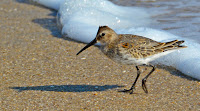DUNLIN
DUNLIN – (Calidris alpina) (See images below)
DESCRIPTION: The Dunlin is a small wading shorebird. The top parts are mottled brown and the rump is white, while the breast is white with grey-brown streaks. In breeding plumage the belly turns black and the back turns reddish-brown. The dunlin’s black bill is slightly longer than the head, which can differentiate it from the Semipalmated Sandpiper and the Sanderling in the fall. The long legs also are black. Sexes are similar. This bird is around 7 inches long (20 cm).
VOICE: https://www.xeno-canto.org/species/Calidris-alpina
NAME: The English name ‘Dunlin’ derives from Anglo-Saxon ‘dunn’ for ‘dark’ and ‘lin’ for ‘little one’, in reference to the bird in breeding plumage. The Latin genus name ‘Calidris’ means a grey-speckled shorebird. As for the Latin species name ‘alpina’, it means ‘mountain’, but this is not a mountain bird. Rather, the name stems from the ‘mountain-like climate’ where it breeds, the Arctic.
HABITAT: Tundra along the coasts during the summer; mudflats, beaches, and marshes in the winter.
DIET: Dunlins forages in shallow water for small crustaceans and other invertebrates.
NESTING: The nest is a scrape on the ground. About four beige eggs with brown blotches are laid, which are incubated by the parents.
DISTRIBUTION: The breeding range of the dunlin covers most of the Arctic, and it migrates along mainly the coasts of Asia, Europe and North America for the winter. Some individuals will winter on Pacific islands such as Hawaii.
DISTRIBUTION MAP: https://en.wikipedia.org/wiki/Dunlin#/media/File:CalidrisAlpinaIUCNver2018_2.png
ON PEI: During its fall migration the dunlin visits Prince Edward Island beaches on its way to the Atlantic coast of the USA.
CONSERVATION: The overall population of the dunlin is large and widespread, but it has been declining steadily over the last few decades. Threats include oil pollution, wetland degradation such as drainage for development or irrigation, and predation of eggs and chicks. In spite of these concerns the species is still listed as not at risk.
NOTES: Dunlins will form large flocks during migration.
SIMILAR SPECIES: Sanderling, Semipalmated Sandpiper
REFERENCES: https://en.wikipedia.org/wiki/Dunlin
https://www.allaboutbirds.org/guide/Dunlin/id
https://www.audubon.org/field-guide/bird/dunlin
http://www.arkive.org/dunlin/calidris-alpina/
https://www.borealbirds.org/bird/dunlinhttp://www.nhptv.org/natureworks/dunlin.htm (New Hampshire PBS)
Here is a dunlin foraging on the Brackley Beach, PEI National Park, during the fall:
DESCRIPTION: The Dunlin is a small wading shorebird. The top parts are mottled brown and the rump is white, while the breast is white with grey-brown streaks. In breeding plumage the belly turns black and the back turns reddish-brown. The dunlin’s black bill is slightly longer than the head, which can differentiate it from the Semipalmated Sandpiper and the Sanderling in the fall. The long legs also are black. Sexes are similar. This bird is around 7 inches long (20 cm).
VOICE: https://www.xeno-canto.org/species/Calidris-alpina
NAME: The English name ‘Dunlin’ derives from Anglo-Saxon ‘dunn’ for ‘dark’ and ‘lin’ for ‘little one’, in reference to the bird in breeding plumage. The Latin genus name ‘Calidris’ means a grey-speckled shorebird. As for the Latin species name ‘alpina’, it means ‘mountain’, but this is not a mountain bird. Rather, the name stems from the ‘mountain-like climate’ where it breeds, the Arctic.
HABITAT: Tundra along the coasts during the summer; mudflats, beaches, and marshes in the winter.
DIET: Dunlins forages in shallow water for small crustaceans and other invertebrates.
NESTING: The nest is a scrape on the ground. About four beige eggs with brown blotches are laid, which are incubated by the parents.
DISTRIBUTION: The breeding range of the dunlin covers most of the Arctic, and it migrates along mainly the coasts of Asia, Europe and North America for the winter. Some individuals will winter on Pacific islands such as Hawaii.
DISTRIBUTION MAP: https://en.wikipedia.org/wiki/Dunlin#/media/File:CalidrisAlpinaIUCNver2018_2.png
ON PEI: During its fall migration the dunlin visits Prince Edward Island beaches on its way to the Atlantic coast of the USA.
CONSERVATION: The overall population of the dunlin is large and widespread, but it has been declining steadily over the last few decades. Threats include oil pollution, wetland degradation such as drainage for development or irrigation, and predation of eggs and chicks. In spite of these concerns the species is still listed as not at risk.
NOTES: Dunlins will form large flocks during migration.
SIMILAR SPECIES: Sanderling, Semipalmated Sandpiper
REFERENCES: https://en.wikipedia.org/wiki/Dunlin
https://www.allaboutbirds.org/guide/Dunlin/id
https://www.audubon.org/field-guide/bird/dunlin
http://www.arkive.org/dunlin/calidris-alpina/
https://www.borealbirds.org/bird/dunlinhttp://www.nhptv.org/natureworks/dunlin.htm (New Hampshire PBS)
 |
| Dunlins in breeding plumage, Baltic Sea, Germany - July 2016, by Andreas Eichler |
 |
| Dunlin, adult in winter plumage, Sandy Hook, NJ - Nov. 2014, by Spinusnet |
 |
| Dunlin close up, Johnson's Shore, PEI, Canada - Oct. 3, 2016, © Lois Kilburn |